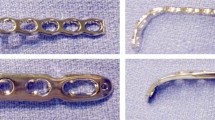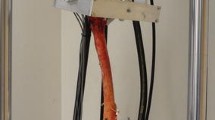Abstract
Purpose
Intramedullary nailing and locked plating for fixation of olecranon fractures has recently gained popularity. However, these two new technologies have not been compared for their biomechanical efficacy. The aim of this study was to evaluate the biomechanical stability of two newly designed fracture fixation devices for treating olecranon fractures during dynamic continuous loading: the ION intramedullary locking nail and the LCP precontoured locking compression plate.
Methods
Simulated oblique olecranon fractures were created in eight pairs of fresh-frozen cadaver ulnae and stabilised using either the LCP or ION. Specimens were then subjected to continuous dynamic loading (from 25 to 200 N), with a continuous angle alteration between 0° and 90° of flexion, to perform a matched-pairs comparison. Significant differences in the distance between markers surrounding the fracture gap was determined using the Wilcoxon test after four and 300 loading cycles.
Results
The ION resulted in significantly less displacement in the fracture gap at 0° extension (P = 0.036), 45° flexion (P = 0.035) and 90° flexion (P = 0.017) after 300 cycles of continuous loading. The measured displacements were small and were probably not of clinical significance. No mechanical failure or hardware migration was seen with either fixation technique.
Conclusion
This study shows significantly less micromotion for the ION than for the LCP in treating oblique olecranon fractures after 300 cycles of dynamic loading. Both implant types could be appropriate surgical techniques for fixation of selected olecranon fractures and osteotomies.





Similar content being viewed by others
References
Rommens PM, Kuchle R, Schneider RU, Reuter M (2004) Olecranon fractures in adults: factors influencing outcome. Injury 35:1149–1157. doi:10.1016/j.injury.2003.12.002
Macko D, Szabo RM (1985) Complications of tension-band wiring of olecranon fractures. J Bone Joint Surg Am 67:1396–1401
Murphy DF, Greene WB, Dameron TB Jr (1987) Displaced olecranon fractures in adults. Clinical evaluation. Clin Orthop Relat Res 215–223
Hume MC, Wiss DA (1992) Olecranon fractures. A clinical and radiographic comparison of tension band wiring and plate fixation. Clin Orthop 229–235
Edwards SG, Argintar E, Lamb J (2011) Management of comminuted proximal ulna fracture–dislocations using a multiplanar locking intramedullary nail. Tech Hand Up Extrem Surg 15:106–114. doi:10.1097/BTH.0b013e3181f7ce5d
Newman SD, Mauffrey C, Krikler S (2009) Olecranon fractures. Injury 40:575–581. doi:10.1016/j.injury.2008.12.013
Kloen P, Buijze GA (2009) Treatment of proximal ulna and olecranon fractures by dorsal plating. Oper Orthop Traumatol 21:571–585. doi:10.1007/s00064-009-2006-y
Buijze GA, Blankevoort L, Tuijthof GJ, Sierevelt IN, Kloen P (2010) Biomechanical evaluation of fixation of comminuted olecranon fractures: one-third tubular versus locking compression plating. Arch Orthop Trauma Surg 130:459–464. doi:10.1007/s00402-009-0980-z
Fyfe IS, Mossad MM, Holdsworth BJ (1985) Methods of fixation of olecranon fractures. An experimental mechanical study. J Bone Joint Surg Br 67:367–372
Murphy DF, Greene WB, Gilbert JA, Dameron TB Jr (1987) Displaced olecranon fractures in adults. Biomechanical analysis of fixation methods. Clin Orthop 210–214
Nowak TE, Mueller LP, Burkhart KJ, Sternstein W, Reuter M, Rommens PM (2007) Dynamic biomechanical analysis of different olecranon fracture fixation devices—tension band wiring versus two intramedullary nail systems: an in-vitro cadaveric study. Clin Biomech (Bristol, Avon) 22:658–664. doi:10.1016/j.clinbiomech.2007.02.003
Molloy S, Jasper LE, Elliott DS, Brumback RJ, Belkoff SM (2004) Biomechanical evaluation of intramedullary nail versus tension band fixation for transverse olecranon fractures. J Orthop Trauma 18:170–174
An KN, Morrey BF (2000) Biomechanics of the elbow. In: Morrey BF (ed) The elbow and its disorders, 3rd edn. W. B. Saunders, Philadelphia, pp 43–60
Nowak TE, Burkhart KJ, Mueller LP, Mattyasovszky SG, Andres T, Sternstein W, Rommens PM (2010) New intramedullary locking nail for olecranon fracture fixation—an in vitro biomechanical comparison with tension band wiring. J Trauma 69:E56–E61. doi:10.1097/TA.0b013e3181c9af9b
Edwards SG, Martin BD, Fu RH, Gill JM, Nezhad MK, Orr JA, Ferrucci AM, Love JM, Booth R, Singer A, Hsieh AH (2011) Comparison of olecranon plate fixation in osteoporotic bone: do current technologies and designs make a difference? J Orthop Trauma 25:306–311. doi:10.1097/BOT.0b013e3181f22465
Davenport SR, Lindsey RW, Leggon R, Miclau T, Panjabi M (1988) Dynamic compression plate fixation: a biomechanical comparison of unicortical vs bicortical distal screw fixation. J Orthop Trauma 2:146–150
Koval KJ, Hoehl JJ, Kummer FJ, Simon JA (1997) Distal femoral fixation: a biomechanical comparison of the standard condylar buttress plate, a locked buttress plate, and the 95-degree blade plate. J Orthop Trauma 11:521–524
Sadri H, Stern R, Singh M, Linke B, Hoffmeyer P, Schwieger K (2011) Transverse fractures of the olecranon: a biomechanical comparison of three fixation techniques. Arch Orthop Trauma Surg 131:131–138. doi:10.1007/s00402-010-1156-6
Conflict of interest
No benefits in any form have been or will be received from a commercial party related directly or indirectly to the subject of this study by any of the authors. The biomechanical laboratory of the Department of Trauma Surgery of the Johannes Gutenberg University Mainz is supported by a yearly grant of Synthes, Bettlach, Switzerland. The ION prototypes were donated by Synthes, Bettlach, Switzerland.
Author information
Authors and Affiliations
Corresponding author
Rights and permissions
About this article
Cite this article
Nowak, T.E., Burkhart, K.J., Andres, T. et al. Locking-plate osteosynthesis versus intramedullary nailing for fixation of olecranon fractures: a biomechanical study. International Orthopaedics (SICOT) 37, 899–903 (2013). https://doi.org/10.1007/s00264-013-1854-0
Received:
Accepted:
Published:
Issue Date:
DOI: https://doi.org/10.1007/s00264-013-1854-0




